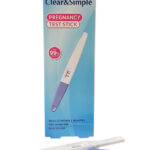

Clear & Simple Pregnancy Test Sticks 2’s
KSh 500.00
Clear & Simple Pregnancy Test Strip measures the presence of the hormone human Chorionic Gonadotropin (HCG) in human urine for early detection of pregnancy.
The concentration of HCG in a non-pregnant woman is usually 5mIU. At the time of the missed period the concentration rises to about 100mIU. The test is sensitive to 20mIU of HCG and is capable of detecting pregnancy as early as 7-10 days after conception. We do however recommend that you wait until the first day after your missed period to get a reliable result.
How to Test
Open the sealed pouch and remove the strip.
Place the test strip vertically (straight) into the urine sample, making sure the arrows are pointing down. Do not allow the urine surface to go above the maximum level line (marked by arrows) on the test strip.
Leave the strip in the urine for at least 8 seconds (recommend 10 seconds).
Remove the pregnancy test and place on a dry flat surface.
Wait for coloured bands to appear, depending on the concentration of HCG, results can be seen in as little as 40 seconds. However to confirm a negative result the complete reaction time (5 minutes) is required.
Discard the test after use, put the used test in a special container and if possible regard it as infectious.
Reading the result
POSITIVE RESULT
If two coloured lines appear on the test strip, you are pregnant. One line may appear lighter than the other, but they will both be the same thickness. A faint line is more likely to occur when you are testing early and your hCG levels are low. See Questions 5 and 7 in the frequently asked questions.
NEGATIVE RESULT
If only one coloured line appears on the test strip this is a negative result and you are either not pregnant or you may have tested too early. If you are unsure repeat the test in 48 hours with a new test strip. See Questions 6 and 7 in the frequently asked questions.
INVALID RESULT
If no lines appear anywhere on the test strip or if only the test line appears, the test has not worked properly and is invalid. This is usually due to the strip not being wet enough. Repeat the test with a new test strip ensuring that the strip is immersed in the urine sample for the full 10 seconds. See Question 4 in the frequently asked questions.
Related products
Malanil Adult 250mg/100mg Tablets 12’s











